The 30 Best Places to Live in Virginia: Top Cities and Towns

Virginia offers residents an exceptional combination of historical significance, natural beauty, and modern amenities that make it one of the most desirable states to call home.
From the Atlantic coastline to the Blue Ridge Mountains, the state provides diverse communities that cater to different lifestyles and preferences.
This comprehensive analysis examines thirty communities across Virginia, evaluating each location based on factors such as cost of living, educational opportunities, economic growth, and quality of life metrics.
The featured locations range from bustling metropolitan areas like Arlington and Richmond to charming historic towns such as Williamsburg and colonial settlements that have evolved into thriving modern communities.
Each destination offers unique advantages, whether residents prioritize career opportunities, family-friendly environments, cultural attractions, or outdoor recreation.
Here are the 30 best places to live in Virginia:
30. Colonial Heights
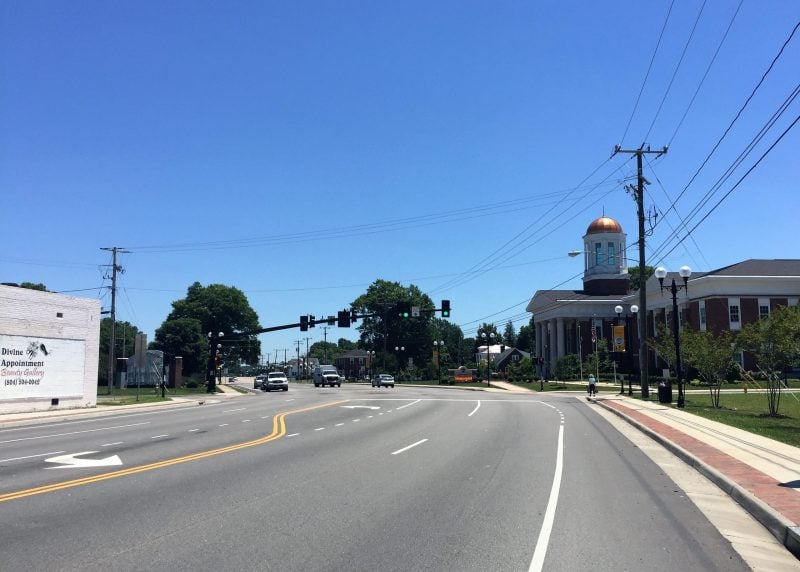
Colonial Heights is a suburb of Richmond with a population of 18,210 residents. The city offers a sparse suburban feel where most residents own their homes.
Home prices in Colonial Heights remain below Virginia’s state average of $323,261. This makes it an affordable option for homebuyers seeking value in the Richmond metropolitan area.
The city features numerous restaurants and parks for residents to enjoy. Multiple museums provide insight into the area’s rich historical background.
Colonial Heights ranks among Virginia’s suburbs with the lowest cost of living. It also appears on lists of best places to retire in the state.
Fort Lee nearby offers various family-friendly events and exhibits throughout the year. The location provides convenient access to Richmond while maintaining a quieter suburban atmosphere.
Residents appreciate the community’s blend of affordability, history, and recreational amenities.
29. Winchester
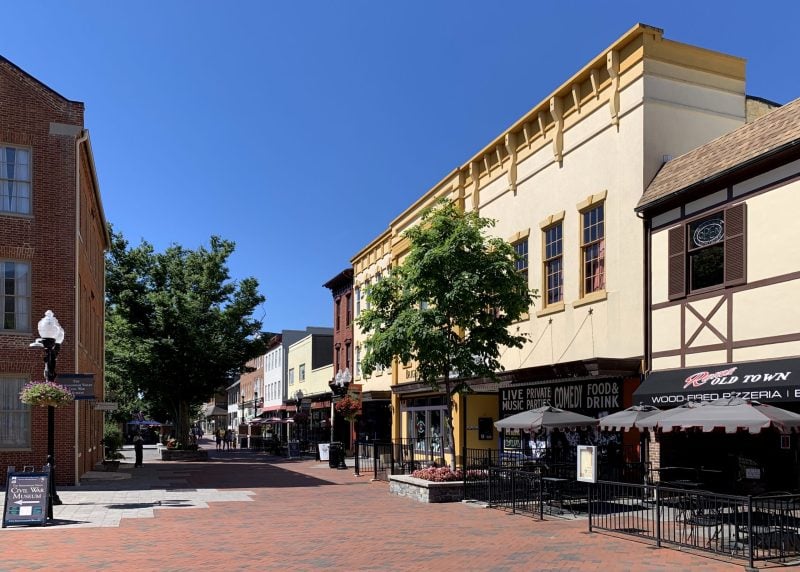
Winchester offers residents a dense suburban feel with a population of 27,981. The city sits in Virginia’s northwestern region within the scenic Shenandoah Valley.
Most residents rent their homes rather than own. The neighborhoods vary significantly in quality and median home values across different areas.
Winchester provides abundant dining options, coffee shops, and parks for residents. The city maintains a small-town atmosphere while offering modern amenities.
The location appeals to families, retirees, and professionals seeking a quieter lifestyle. Its historical significance and scenic surroundings contribute to the area’s charm.
Winchester serves as a suitable option for those starting careers, changing professions, or entering retirement. The city combines accessibility with a relaxed pace of living.
Crime rates tend to be lower in the higher-value neighborhoods. The overall quality of life varies depending on the specific area within Winchester.
28. Martinsville
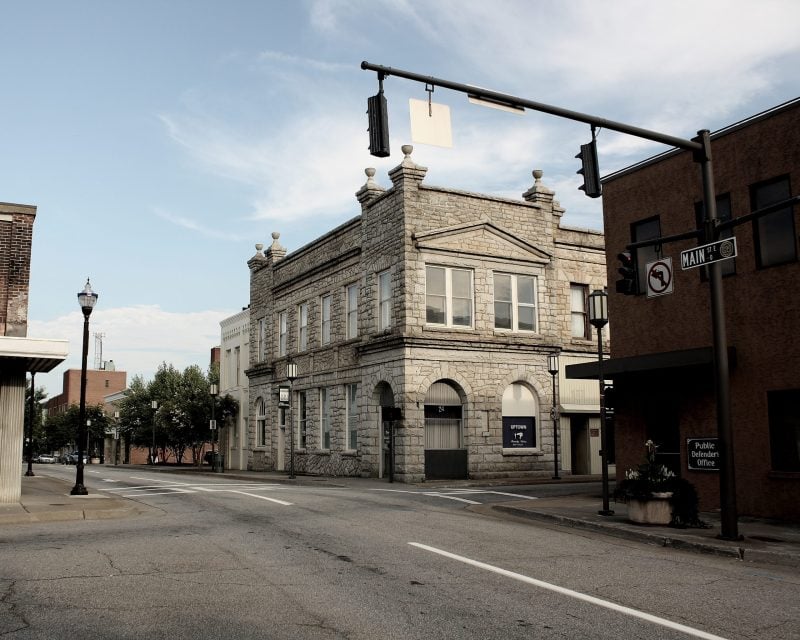
Martinsville is an independent city in Henry County with a population of 13,584. The city ranks 20th out of 524 places for lowest cost of living in Virginia.
Home prices in Martinsville are significantly lower than Virginia’s state average of $323,261. This affordability makes it attractive for homebuyers seeking value.
The city offers a sparse suburban feel where most residents own their homes. Many retirees choose to live in Martinsville due to its quiet atmosphere and low living costs.
Martinsville provides access to outdoor recreation through multiple trails for biking and jogging. Nearby Philpott Lake offers scenic views and water activities.
The city features various shops and restaurants that serve the local community. Residents enjoy small-town quality of life without major traffic congestion.
Martinsville’s location provides convenient access to both mountain and beach regions of Virginia.
27. Radford
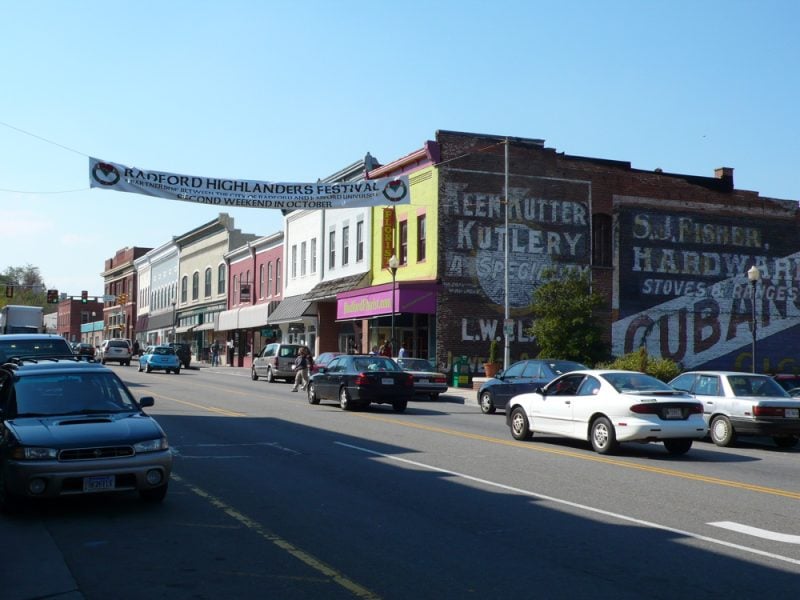
Radford is a small city located in the Blue Ridge foothills of southwest Virginia with a population of just over 16,000 people. The city offers residents a dense suburban feel in a picturesque mountain setting.
Radford ranks favorably for cost of living, placing 101st out of 524 Virginia places for lowest living costs. Home prices remain below the state average of $323,261, making housing more affordable for residents.
The city’s public schools perform above average, ranking 107th out of 280 places statewide for educational quality. This attracts families seeking good educational opportunities for their children.
Many young professionals choose to live in Radford, with most residents renting their homes rather than buying. The city provides access to outdoor activities in the surrounding Blue Ridge Mountains while maintaining small-town charm and community atmosphere.
26. Bedford

Bedford sits nestled in the foothills of the Blue Ridge Mountains in central Virginia. The town offers residents a peaceful atmosphere surrounded by rolling hills and natural beauty.
The area provides numerous outdoor recreational opportunities. Hiking, biking, camping, and fishing are popular activities for residents who enjoy spending time in nature.
Bedford’s downtown area maintains a charming small-town character. Local farmers markets supply fresh produce, locally-sourced meats, and homemade goods to the community.
Housing costs in Bedford remain below Virginia’s state average of $323,261. This affordability makes the town attractive for families and retirees seeking value.
Bedford County ranks 20th for public schools statewide and 27th among Virginia’s best counties to live in. The area also ranks 21st for retirement destinations in the state.
Central Virginia Community College operates a facility in Bedford, providing higher education access to local residents.
25. Vienna
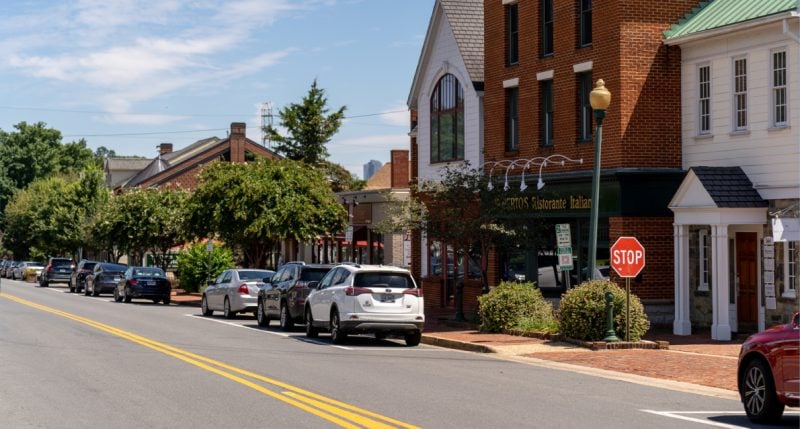
Vienna ranks among Virginia’s most desirable communities according to multiple 2025 rankings. This Fairfax County suburb sits near Washington, D.C. with a population of approximately 16,500 residents.
The town offers exceptional safety with crime rates nearly 50% lower than the national average. Vienna’s public school system ranks in the top 5% nationally, making it attractive to families.
Residents enjoy a sparse suburban atmosphere with most owning their homes. The area features numerous restaurants, coffee shops, and parks throughout the community.
Vienna’s median household income reaches $168,269, significantly above the national average of $67,500. The poverty rate stands at just 4%, which is 71% lower than the national rate.
Job opportunities remain strong in nearby tech, healthcare, and government sectors. Home prices exceed Virginia’s state average, reflecting the area’s desirability and market demand.
24. Salem
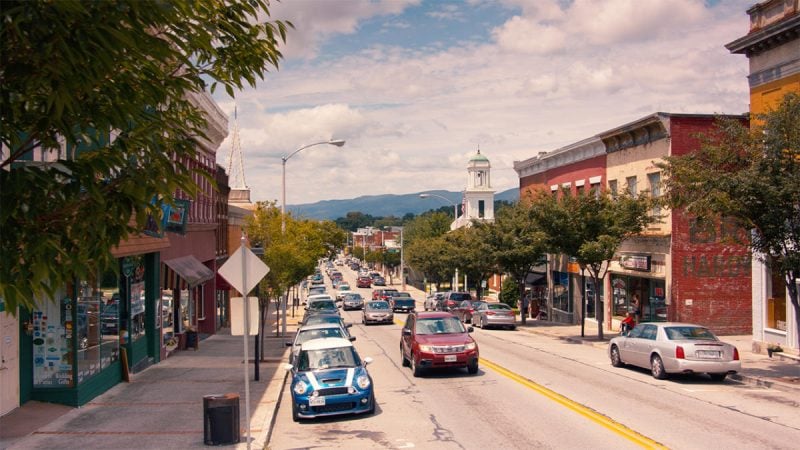
Salem stands out as one of Virginia’s most appealing suburban communities with a population of 25,477. The city offers residents a sparse suburban atmosphere where most people own their homes.
Located in southwestern Virginia along the Blue Ridge Mountains, Salem provides access to numerous parks and recreational opportunities. The area attracts many young professionals seeking quality living options.
The city maintains a low crime rate and provides residents with a high quality of life. Salem’s public schools receive high ratings, making it attractive for families.
Housing costs in Salem remain below Virginia’s state average of $323,261. This affordability combined with excellent amenities contributes to Salem’s reputation as a welcoming community.
Salem ranks among the top places to live in Virginia according to multiple ranking systems. The pleasant months of September, June, and May showcase the area’s natural beauty.
23. Lynchburg
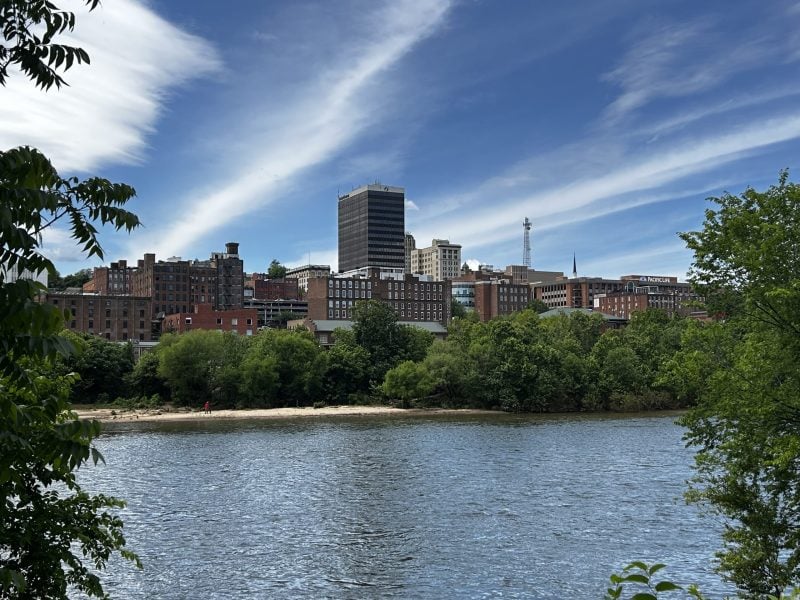
Lynchburg sits in west-central Virginia along the James River with a population of 79,255. The city offers residents a dense suburban feel with numerous parks throughout the area.
Most residents rent their homes in this college town. Young professionals make up a significant portion of the population, drawn to the city’s employment opportunities and amenities.
The public schools perform above average, making it attractive for families. Lynchburg has earned recognition as one of 2025’s Top 100 Best Places to Live according to Livability.com.
The city blends historic districts with modern development. A large riverfront park serves as a focal point for recreation and community events.
Residents experience lower rates of stress, depression, and obesity compared to many other cities nationwide. This health advantage contributes to Lynchburg’s reputation as both a happy and healthy place to live.
22. Staunton

Staunton ranks 8th among Virginia’s best places to live according to recent rankings. The city sits in the scenic Shenandoah Valley with a population of 25,765 residents.
This historic city was founded in 1747 and played a significant role in Civil War events. The well-preserved downtown architecture reflects centuries of American history.
Residents enjoy a dense suburban feel with most people owning their homes. The city attracts both young professionals and retirees seeking quality living.
Staunton offers numerous parks and recreational opportunities. The cost of living remains relatively low compared to other Virginia cities.
The median household income is $62,115, which falls below the national average of $79,466. However, the lower living costs help offset this difference.
The city provides strong economic growth and maintains low unemployment rates. Educational opportunities and healthcare access contribute to its high livability ranking.
21. Herndon
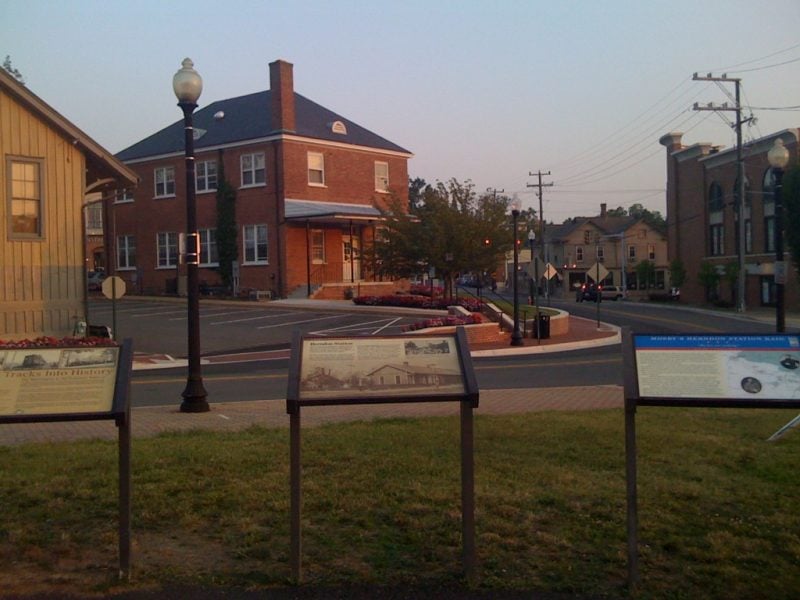
Herndon stands as one of Virginia’s most desirable suburban communities, located in Fairfax County with a population of 24,529. The town offers residents an urban-suburban mix with excellent access to Washington, D.C.
Most residents own their homes in this well-established community. The area features numerous restaurants, coffee shops, and parks that enhance daily living.
Herndon ranks impressively for safety, placing 7th out of 200 communities for low crime rates. The cost of living index ranks 21st out of 200, indicating reasonable expenses for the quality of life provided.
Home prices exceed Virginia’s state average of $323,261, reflecting the area’s desirability and strong market demand. The higher housing costs correspond with the community’s proximity to the nation’s capital and quality amenities.
The town combines historic neighborhoods with modern developments, attracting both families and individuals seeking a vibrant community atmosphere.
20. Portsmouth
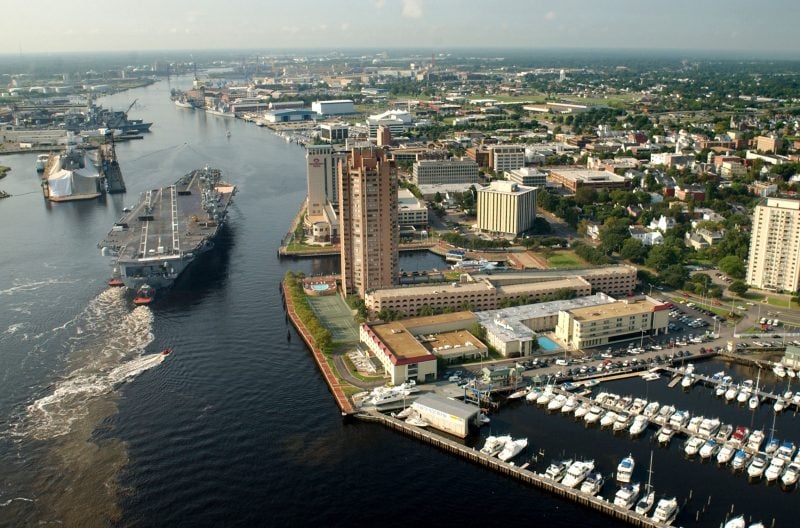
Portsmouth offers an affordable alternative to Virginia’s pricier housing markets. Home prices fall well below the state average of $323,261, making homeownership accessible for families and young professionals.
The city ranks #90 out of 552 U.S. cities overall for quality of life. Portsmouth also scores #87 out of 545 cities for diversity, creating a welcoming environment for residents from various backgrounds.
This dense suburban community features numerous parks and recreational areas. Most residents own their homes, contributing to neighborhood stability and community investment.
Portsmouth attracts both families seeking affordable housing and young professionals working in the area. The city’s proximity to the shipyards provides employment opportunities in maritime industries.
Established neighborhoods like Cavalier Manor offer strong community connections. The city maintains a balance between suburban comfort and urban amenities for its 97,299 residents.
19. Suffolk
Suffolk stands as Virginia’s largest city by land area, offering residents a distinctive combination of urban amenities and rural charm. The city sits in the Hampton Roads region with a population of 96,638.
Residents enjoy a sparse suburban atmosphere where most people own their homes. The community attracts many families and young professionals seeking this balanced lifestyle.
Suffolk features abundant parks and green spaces throughout the city. The Great Dismal Swamp National Wildlife Refuge provides exceptional outdoor recreation opportunities for nature enthusiasts.
The historic downtown area preserves Colonial-era architecture and character. This creates an appealing blend of past and present for residents and visitors.
Housing quality varies significantly across different neighborhoods within the city. The best areas typically correlate with higher median home values and lower crime rates.
Suffolk’s location provides convenient access to Norfolk, Chesapeake, and Virginia Beach within 30 miles.
18. Newport News
Newport News sits strategically on the Virginia Peninsula along the James River. The city has a population of 184,774 residents and offers a dense suburban atmosphere.
Most residents rent their homes in this independent city. The area attracts many families and young professionals seeking affordable housing options.
The city spans 23 miles along the James River and Hampton Roads Harbor. This location has made Newport News historically important for shipbuilding and maritime commerce.
Residents enjoy numerous restaurants, coffee shops, and parks throughout the city. The area provides easy access to recreational activities along the Chesapeake Bay coastline.
Newport News offers varying neighborhood quality and home values across different areas. The housing market shows significant disparity between different parts of the city.
The location provides proximity to Colonial Williamsburg and other Hampton Roads attractions. Beach access, hiking trails, and outdoor recreation opportunities are readily available to residents.
17. Leesburg
Leesburg stands as one of Virginia’s most desirable suburban communities, located in Loudoun County just outside Washington, D.C. The city serves approximately 48,788 residents with a dense suburban atmosphere.
Most residents own their homes in this well-established community. The area offers numerous parks and outdoor recreation opportunities throughout the city.
Leesburg sits in the foothills of the Blue Ridge Mountains, providing scenic views and mild weather year-round. The location combines historic charm with modern amenities.
The city features top-rated schools and strong job opportunities, particularly for those commuting to the D.C. metropolitan area. Its diverse population contributes to a vibrant cultural scene.
Home prices in Leesburg exceed Virginia’s state average of $323,261. The higher cost reflects the area’s desirability and proximity to major employment centers.
Historic sites, exceptional dining, and shopping options add to Leesburg’s appeal for families and professionals.
16. Manassas
Manassas sits 30 miles west of Washington, D.C., offering residents suburban living with urban accessibility. The city has a population of approximately 42,674 people in a dense suburban setting.
The historic Old Town district features charming shops and restaurants. Georgetown South provides affordable housing options for diverse residents.
Point of Woods attracts families with townhomes and community amenities. Cannon Ridge offers newer single-family homes near excellent schools.
Most residents own their homes in this family-friendly community. The city appeals to both families and young professionals seeking quality neighborhoods.
Manassas provides numerous restaurants, coffee shops, and parks throughout the area. The poverty rate of 7% sits well below the national average.
The typical household earns $86,227 annually, significantly higher than the national median of $67,500. Housing options range from brick colonials to luxury townhouses and modern condominiums.
15. Fairfax
Fairfax stands as one of Virginia’s premier suburban destinations, ranking 6th nationally for best places to live. The city maintains an impressive livability score of 81 out of 100.
The community offers residents a dense suburban environment where most people own their homes. Fairfax provides extensive dining options, coffee shops, and recreational parks throughout the area.
Education excellence defines this Washington D.C. suburb. The city ranks 2nd nationally for public schools, making it particularly attractive to families with children.
Safety remains a top priority, with Fairfax earning 3rd place nationally for security. The robust local economy provides strong employment opportunities for residents.
Fairfax delivers superior access to employment centers and cultural attractions. Neighborhoods feature clean streets, abundant greenery, and active community engagement through regular civic events.
The area’s proximity to the nation’s capital enhances its appeal while maintaining suburban charm.
14. Blacksburg
Blacksburg stands out as one of Virginia’s premier college towns, anchored by Virginia Tech University. The city offers residents an urban-suburban mix with a population of 45,288 in Montgomery County.
Most residents rent their homes due to the strong student population. Young professionals gravitate toward the area for its vibrant atmosphere and educational opportunities.
The town sits surrounded by the Blue Ridge Mountains in southwestern Virginia. This location provides scenic views and outdoor recreation access for residents.
Downtown Blacksburg attracts students and young professionals seeking an active urban lifestyle. The Hethwood neighborhood appeals to families with its excellent schools and community amenities.
Livability.com recently recognized Blacksburg as one of the best places to live in Virginia. The community thrives on innovation, education, and strong social connections.
The area features numerous parks and green spaces throughout the city. Housing quality varies significantly across different neighborhoods based on median home values.
13. Falls Church
Falls Church stands out as a premier suburb of Washington, D.C. with a population of 14,593 residents. The city consistently ranks among Virginia’s best places to live.
Most residents own their homes in this urban-feeling community. The area offers numerous restaurants, coffee shops, and parks for daily amenities.
Falls Church boasts Virginia’s top-ranked public school system. Falls Church High School earned the number one ranking among 30 high schools in the Fairfax County Public School System.
The city maintains low crime rates and provides access to recreational activities like hiking along the Potomac River. These factors contribute to its high quality of life ratings.
Home prices exceed Virginia’s state average of $323,261, reflecting the area’s desirability. The higher costs align with the premium location and excellent amenities Falls Church provides to residents.
12. Harrisonburg
Harrisonburg sits in Virginia’s scenic Shenandoah Valley with a population of approximately 51,500 residents. The city offers a dense suburban atmosphere where most residents rent their homes.
The community attracts many young professionals and college students due to James Madison University’s presence. Public schools perform above average, making it appealing for families.
Residents enjoy numerous restaurants, parks, and outdoor recreation opportunities throughout the valley. The natural beauty of the surrounding Shenandoah region provides hiking trails and scenic landscapes.
Housing costs remain relatively affordable compared to northern Virginia markets. The area has experienced steady growth as Virginia’s second-fastest growing region.
Crime rates tend to be lower in the better neighborhoods, though housing quality varies significantly across different areas. The city ranks #16 among Virginia’s best places to live.
Cultural diversity and a vibrant downtown area contribute to Harrisonburg’s appeal for various demographics.
11. Ashburn
Ashburn stands as one of Virginia’s premier communities, consistently ranking among the best places to live in the state. This Loudoun County suburb of Washington, D.C. houses 45,551 residents in a dense suburban environment.
The area offers excellent safety ratings and high quality of life scores. Most residents own their homes, creating a stable community atmosphere.
Ashburn provides abundant amenities including numerous restaurants, coffee shops, and parks. The town’s proximity to D.C. makes it attractive for commuters, with new Metro stations planned nearby.
The community boasts remarkable diversity, with over 30% of residents being foreign-born. This adds significant cultural richness to the area.
However, living costs run high. The median home price reaches $752,057, nearly double Virginia’s average of $371,302. Overall living expenses are 51% higher than the national average.
10. Chesapeake
Chesapeake ranks as one of Virginia’s most desirable places to live, with a population of 251,153 residents. The city offers a sparse suburban feel where most residents own their homes.
Located in the Hampton Roads region, Chesapeake provides diverse neighborhoods that blend urban convenience with rural charm. Families and young professionals are drawn to the area’s excellent amenities.
Greenbrier serves as the commercial center with major highways converging for easy commuting. Great Bridge offers excellent schools and a family-friendly atmosphere with suburban appeal.
The city features numerous parks and recreational opportunities throughout its neighborhoods. Deep Creek South and Western Branch provide safe, welcoming communities for residents.
Chesapeake’s stable real estate market offers affordable living options compared to other Virginia cities. The area maintains low crime rates and strong educational systems that attract new residents consistently.
9. Williamsburg
Williamsburg stands as one of Virginia’s most desirable communities, combining rich colonial history with modern suburban living. This incorporated city houses approximately 15,564 residents in a dense suburban environment.
The city offers residents excellent quality of life with numerous parks, restaurants, and recreational amenities. Freedom Park provides outdoor activities and nature experiences for families and individuals alike.
Most Williamsburg residents own their homes, reflecting the community’s stability and desirability. The neighborhoods vary significantly in character and home values, creating options for different budgets and preferences.
Colonial Williamsburg serves as the area’s crown jewel, drawing tourists while providing residents with unique cultural and historical experiences. The city’s location in James City County offers convenient access to the greater Hampton Roads region.
Williamsburg consistently ranks among Virginia’s top places to live due to its blend of historical significance, community amenities, and suburban comfort.
8. Reston
Reston stands out as one of Northern Virginia’s premier planned communities. Located in Fairfax County, this vibrant town houses 63,542 residents who enjoy an urban-suburban lifestyle.
The community offers excellent walkability and convenience. Reston Town Center serves as the heart of the area, featuring over 50 shops, restaurants, and services including major retailers like Apple Store and J.Crew.
Residents benefit from abundant outdoor recreation opportunities. Lake Fairfax Park and Riverbend Park provide hiking, boating, and nature activities. The Washington & Old Dominion Trail offers scenic walking and biking paths.
The area maintains strong market appeal with home values significantly above Virginia’s state average of $323,261. Most residents own their homes and appreciate the mix of urban amenities without big city complications.
Reston consistently ranks among Virginia’s best places to live, recently placing second in U.S. News rankings behind Burke.
7. Roanoke
Roanoke sits in the heart of the Blue Ridge Mountains, offering residents a blend of urban amenities and outdoor recreation. The city provides an affordable cost of living compared to many Virginia metropolitan areas.
The job market remains strong with opportunities across various industries. Young professionals and families find the area particularly appealing for career growth and quality of life.
Outdoor enthusiasts enjoy extensive hiking and biking trails throughout the surrounding mountains. Mill Mountain Park and Explore Park provide recreational activities within the city limits.
South Roanoke features upscale neighborhoods with historic homes and tree-lined streets. Grandin Village offers a small-town atmosphere with local shops and restaurants.
Cave Spring provides suburban living with highly-rated schools and diverse housing options. The area attracts families seeking good educational opportunities.
Roanoke earned recognition on Livability.com’s 2025 Top 100 Best Places to Live list. This ranking reflects the city’s appeal to residents seeking both career opportunities and recreational activities.
6. Fredericksburg
Fredericksburg offers residents an urban-suburban mix with a population of 28,383. The city combines rich history with modern amenities in a welcoming community setting.
Most residents rent their homes in this Fredericksburg City County location. The area attracts many families and young professionals seeking convenient living options.
The city features numerous restaurants, coffee shops, and parks throughout its neighborhoods. These amenities contribute to an active lifestyle for residents.
Fredericksburg’s proximity to Washington, D.C. provides access to employment opportunities and cultural attractions. This location offers the benefits of suburban living while maintaining connections to metropolitan resources.
The city ranks among Virginia’s livable communities, though it faces typical urban challenges. Crime rates, cost of living, and housing availability vary by specific neighborhood within Fredericksburg.
5. Charlottesville
Charlottesville stands out as one of Virginia’s premier destinations for residents seeking quality living. The city maintains a population of approximately 45,863 people.
The University of Virginia anchors the community and creates a vibrant cultural atmosphere. Students and professionals blend together in this college town environment.
Housing costs exceed Virginia’s state average of $323,261, reflecting strong demand for the area. Most residents choose to rent rather than purchase homes.
The Historic Downtown Mall serves as the city’s central hub for dining and entertainment. Restaurants, coffee shops, and retail establishments line this popular gathering space.
Charlottesville offers easy access to both Richmond and Washington D.C. This location provides urban amenities while maintaining a smaller city feel.
The presence of Thomas Jefferson’s Monticello estate adds historical significance to the area. Local wineries and outdoor recreation opportunities enhance the lifestyle options available to residents.
4. Richmond
Richmond serves as Virginia’s capital city and offers residents a blend of historical significance and modern amenities. The city features diverse neighborhoods that cater to different lifestyles and budgets.
Bon Air and Short Pump rank among the most desirable areas for families. These neighborhoods provide access to quality schools and shopping centers.
Richmond maintains a relatively low crime rate compared to other major cities. The area scored 3.6 out of 10 on crime indices, indicating strong public safety.
The city’s cost of living remains reasonable for an urban center. Housing options range from historic districts to newer suburban developments.
Richmond’s job market benefits from government positions and growing private sector opportunities. The presence of state agencies provides employment stability for residents.
Educational institutions and cultural attractions add to the city’s appeal. Multiple universities contribute to a vibrant community atmosphere throughout the metropolitan area.
3. Virginia Beach
Virginia Beach ranks among Virginia’s top cities for residents seeking coastal living. The city earned 30th place out of 150 metro areas in U.S. News & World Report’s best places to live rankings.
This coastal destination offers miles of beaches and an active boardwalk. Residents enjoy outdoor activities like kayaking, paddleboarding, and fishing year-round.
The city provides strong economic opportunities with solid employment rates. Housing values remain competitive compared to other coastal markets.
Virginia Beach maintains low crime rates and quality educational systems. Healthcare facilities throughout the area serve residents’ medical needs effectively.
The community balances tourist attractions with residential neighborhoods. Year-round residents benefit from the city’s recreational amenities without the seasonal crowding of smaller beach towns.
Transportation options connect Virginia Beach to nearby Norfolk and the greater Hampton Roads region.
2. Alexandria
Alexandria sits along the Potomac River with a population of 156,788 residents. The city offers an urban lifestyle where most residents rent their homes rather than own.
The area features diverse neighborhoods ranging from historic Old Town to modern developments. Potomac Yard-Potomac Greens and North Ridge-Rosemont rank among the top neighborhoods for quality of life.
Residents enjoy numerous restaurants, coffee shops, and parks throughout the city. The waterfront location provides dining options with river views and recreational opportunities.
Alexandria serves as one of Virginia’s premier places to live due to its proximity to Washington D.C. The city combines historical landmarks with contemporary amenities.
Housing quality varies significantly across different neighborhoods. Market values reflect the desirability of certain areas, with some commanding premium prices for their location and features.
1. Arlington
Arlington consistently ranks among the top places to live in Virginia and nationwide. Colonial Village, one of its neighborhoods, was recently voted the best place to live in America by Niche.com.
The county offers excellent public schools and maintains low crime rates. Its proximity to Washington D.C. provides abundant job opportunities while offering a suburban feel.
Arlington ranks #3 in Virginia for quality of life according to BestPlaces. The area features diverse neighborhoods ranging from historic communities to modern developments.
Residents benefit from excellent public transportation and walkable neighborhoods. The cost of living is higher than the national average but reflects the area’s desirable amenities and location.
The county attracts professionals and families seeking a balance between urban conveniences and suburban comfort.
Key Factors That Influence Quality of Life
Virginia’s livability depends on four critical elements that shape daily experiences for residents. These factors determine affordability, career prospects, health outcomes, and educational opportunities across the state’s diverse communities.
Economic Opportunities and Job Market
Virginia’s economy centers around several key industries that drive employment growth. Northern Virginia benefits from proximity to Washington D.C., creating robust opportunities in government contracting, cybersecurity, and technology sectors.
Major Employment Sectors:
- Federal government and contracting
- Technology and cybersecurity
- Healthcare and biotechnology
- Military and defense
- Tourism and hospitality
The state’s unemployment rate consistently falls below national averages. Richmond serves as a financial hub with major banking operations. Virginia Beach combines military installations with tourism-related employment.
Tech companies like Amazon have established significant operations in Arlington. This expansion creates high-paying jobs but also increases competition for housing and services.
Hampton Roads region offers maritime and shipbuilding careers. The Port of Virginia provides logistics and transportation jobs that support international trade.
Education and School Systems
Virginia maintains strong public school systems that influence family relocation decisions. Northern Virginia counties consistently rank among the nation’s top school districts for academic performance and college preparation.
Fairfax County Public Schools serves over 180,000 students with advanced programs and technology integration. Loudoun County schools receive recognition for innovation and student achievement rates.
Higher Education Strengths:
- University of Virginia (Charlottesville)
- Virginia Tech (Blacksburg)
- James Madison University (Harrisonburg)
- Virginia Commonwealth University (Richmond)
Private school options exist throughout major metropolitan areas. Many families choose locations based on school district boundaries and performance metrics.
School funding varies by locality since Virginia relies heavily on local property taxes. Wealthier counties typically offer more resources and extracurricular programs.
Healthcare Access
Virginia’s healthcare infrastructure varies significantly between urban and rural areas. Northern Virginia and Richmond offer comprehensive medical facilities with specialized services and research hospitals.
Major Medical Centers:
- Inova Health System (Northern Virginia)
- VCU Medical Center (Richmond)
- Sentara Healthcare (Hampton Roads)
- UVA Health System (Charlottesville)
Rural communities face challenges accessing specialty care and may require travel to urban centers. Telehealth services have expanded to bridge some gaps in remote areas.
Healthcare costs align with national trends but vary by region. Insurance options include employer-sponsored plans and marketplace coverage with varying network accessibility.
The state supports medical education through established programs that help retain healthcare professionals. This investment strengthens long-term care availability across communities.
Cost of Living Considerations
Housing costs represent the largest expense factor affecting quality of life decisions. Northern Virginia commands premium prices due to proximity to Washington D.C. and high-paying job markets.
Virginia Beach and Richmond offer more affordable housing while maintaining urban amenities. Rural areas provide the lowest housing costs but may lack employment diversity.
Key Cost Factors:
- Housing: 20-40% above national average (Northern Virginia)
- Transportation: Moderate due to commuting needs
- Utilities: Generally reasonable statewide
- Food: Slightly above national average in metro areas
State income tax rates range from 2% to 5.75% based on income levels. Property taxes vary dramatically by locality, affecting long-term homeownership costs.
No state sales tax exists on groceries, reducing daily living expenses. Gas prices typically track regional Mid-Atlantic averages with seasonal fluctuations.
Virginia’s Diverse Lifestyles and Communities
Virginia accommodates residents seeking bustling city environments, quiet suburban neighborhoods, or peaceful rural settings across its varied geography. The state provides extensive outdoor recreation from mountain trails to coastal beaches, while historic sites and cultural venues enrich community life throughout the Commonwealth.
Urban vs. Suburban vs. Rural Living
Virginia’s urban centers like Norfolk, Richmond, and Arlington offer high-rise living with walkable neighborhoods and public transportation. These cities provide career opportunities, cultural venues, and dining options within walking distance.
Suburban communities such as Herndon, Manassas Park, and Virginia Beach deliver family-friendly environments with single-family homes and planned neighborhoods. These areas feature good school districts, shopping centers, and community amenities while maintaining reasonable commutes to major employment hubs.
Rural Virginia encompasses mountain towns in the Blue Ridge region and agricultural communities throughout the Shenandoah Valley. These areas offer larger properties, lower population density, and closer connections to farming and outdoor activities.
Housing Options by Region:
- Urban: Condos, townhomes, apartments
- Suburban: Single-family homes, planned communities
- Rural: Farmhouses, estates, mountain cabins
Recreation and Outdoor Activities
The Blue Ridge Mountains provide hiking trails, camping sites, and scenic drives along the Blue Ridge Parkway. Shenandoah National Park offers over 500 miles of trails and numerous waterfalls for outdoor enthusiasts.
Virginia’s Atlantic coastline features Virginia Beach’s boardwalk, Chesapeake Bay’s boating opportunities, and the Eastern Shore’s fishing communities. Lake Anna serves as a popular freshwater destination for swimming, boating, and waterfront living.
State parks throughout Virginia provide camping, fishing, and nature programs. The Virginia Capital Trail connects Richmond to Williamsburg with a 52-mile paved path for cycling and walking.
Cultural Attractions and Events
Virginia’s historical significance provides numerous museums, battlefields, and preserved colonial sites. Colonial Williamsburg, Monticello, and Mount Vernon attract visitors year-round while serving as educational resources for residents.
The Virginia Museum of Fine Arts in Richmond houses international collections. The Kennedy Center’s influence extends into Northern Virginia’s performing arts scene.
Annual events include the Virginia Wine Festival, Shenandoah Apple Blossom Festival, and Norfolk’s Harborfest. These celebrations highlight local agriculture, music, and maritime heritage across different regions of the state.





